MARKET OVERVIEW
The Global Light Gauge Steel Framing market and its industry have been experiencing great traction lately, especially because of increasing demand for cost-effective and durable yet sustainable materials for construction. When buildings are becoming increasingly complex and architects set the boundaries of modern design, the necessity for light but strong material will keep the market going. Light gauge steel framing (LGSF) is gaining ground as a replacement for traditional building materials, offering benefits such as strength, flexibility, and resistance to environmental factors.
The market will be driven by the demand for materials that are both eco-friendly and cost-effective. Steel, being recyclable and able to be used in different forms, will increasingly be used in residential, commercial, and industrial projects. The adoption of steel framing systems will be motivated by the change in green building practices and sustainable development, reducing the carbon footprint as compared to traditional construction methods. This is likely to rise as governments, architects, and contractors are making more emphasis on sustainability in the construction project.
The Global Light Gauge Steel Framing market scope is likely to spread across various sectors of construction. Residential construction is going to be a strong market segment for LGSF, and rising need for cost-effective housing solutions is one of the most important factors. As urbanization is expanding globally, the consumption of light-gauge steel in urban residential buildings will grow. Commercial demand for these systems will increase due to faster construction times with the ability to meet structural needs at lower costs. Besides, the versatility of LGSF in industrial applications will be recognized for its ability to support various manufacturing facilities, warehouses, and storage units.
The scope of the Global Light Gauge Steel Framing market will also cover emerging markets, particularly in Asia-Pacific, where rapid infrastructure development is expected to increase. Countries like India and China, which are particularly booming with a higher rate of urbanization, will tend to widely adapt LGSF as the preferred option for constructing structures. In addition, this will be further supplemented by increased accessibility of automated manufacturing processes and enhanced technology, making it more accessible and affordable for light gauge steel framing systems in regions that are initially not aware of the material.
In coming years, demand for the custom solution and prefabricated steel components will grow, leading to reduced construction time and lowering labor costs for builders. In the very advanced industry, there will be more focus on integrating LGSF with other innovative technologies, including smart building materials, to create structures that are not just energy-efficient but can also adapt to changing needs in the future.
In the long term, the Global Light Gauge Steel Framing market will evolve further because of a change in building methods towards more efficient, sustainable, and cost-effective alternatives. With this market gathering pace, light gauge steel is only going to become more dominant in construction while offering an alternative to conventional framing systems to satisfy the needs of the modern construction landscape. LGSF will be expanded in all sectors, with the direction of its use shaped by technological advancement and sustainability concerns. The future is sure to have more integration of steel framing in residential, commercial, and industrial projects, thereby cementing its place as a crucial material in the construction industry.
Global Light Gauge Steel Framing market is estimated to reach $62,262.88 Million by 2032; growing at a CAGR of 5.3% from 2025 to 2032.
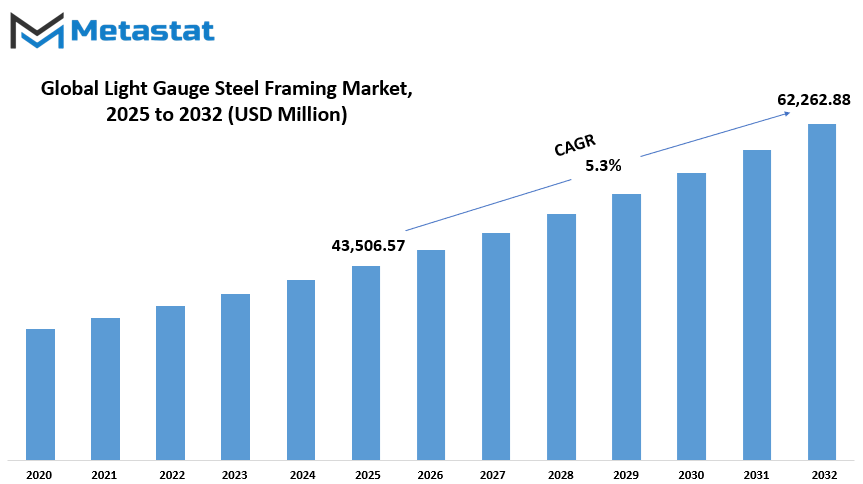
GROWTH FACTORS
The Global Light Gauge Steel Framing market is expected to grow in the coming years, as this is becoming increasingly relevant in modern construction practices. One of the major drivers of this market's growth is the increased focus on sustainable and energy-efficient materials, especially in green building projects. With the growing environmental awareness worldwide, the focus is on the adoption of construction materials that do not only minimize environmental impact but also enhance the energy efficiency of buildings. Light gauge steel framing perfectly fits this trend and hence is an attractive choice for environmentally conscious construction projects.
The other critical driver for the market is the increasing adoption of prefabrication methods in construction. It has benefits of quick construction and lower overall cost due to prefabrication, wherein the components are assembled off-site before transportation to the building site to be installed. This method has become very popular in the construction industry due to the willingness of developers to undertake tight deadlines and budgets without sacrificing the quality. The lightweight and modular properties of light gauge steel framing make it ideal for prefabrication.
However, the market is not without its challenges. One of the notable hurdles is the high cost of materials and fabrication compared to more traditional construction materials. This cost factor may deter some builders and developers, especially those working within limited budgets. Moreover, the limited availability of skilled labor and expertise in light gauge steel framing construction may be an obstacle to its more widespread adoption. The technical know-how for such construction is still relatively scarce in many regions, which may retard market penetration.
Despite these challenges, there is enough scope for growth, particularly in emerging economies that are witnessing rapid urbanization and infrastructure development. As urban populations continue to grow, demand for lightweight and modular construction solutions is expected to increase. These solutions are likely to benefit from reduced available space, narrow construction periods, and cheaply constructed building means. The governmental and private parties that would embark on huge investments in infrastructures will rely more on such creative materials like the light gauge steel framing to bridge the demands created by such aspects.
Advancements in technology and more awareness of the benefits of light gauge steel framing may push it further into the future. Current limitations such as material costs, and expansion of workforce training programs, are all areas where the Global Light Gauge Steel Framing market can be built to succeed in a world increasingly focused on sustainable and efficient building practices.
MARKET SEGMENTATION
By Type
The Global Light Gauge Steel Framing market is growing based on the advancing construction methods where durable, light, and cheap building solutions become in demand. Light gauge steel framing, popular for its ability to be moulded into so many different shapes and forms, becomes a preferred choice in building residential, commercial, as well as industrial projects. Based on its versatile use, strength, and resistance against corrosion, the material has stood out as the leading material used in modern constructions. The market has been segmented based on type, which includes C-shaped, L-shaped, U-shaped, and T-shaped frames. Among these, the C-shaped segment is likely to hold the highest value at $33,833.77 million, with its dominance in all the structural applications.
The pace of urbanization and global attention towards sustainable development have increased the adoption of light gauge steel framing. As the urban populations increase, people require quicker building solutions that save time and can be completed efficiently. Steel framing addresses these needs but also minimizes construction waste; hence, it is an environmental-friendly building process. It will also resist some natural disasters, such as earthquakes and hurricanes, and prove to be an ideal choice for such regions.
Looking forward, technologies will continue to play a greater role in the development of the Global Light Gauge Steel Framing market. Automation in production processes will have the potential for increased accuracy while reducing the production cost, with the possibility of mass production in high-quality components. Additionally, further innovations in the design software and prefabrication techniques will offer increased speed in construction and improve accuracy. Therefore, architects and engineers will more readily use light gauge steel framing for more ambitious projects and complex work.
The market is also segmented by type, which plays a critical role in catering to varied structural needs. C-shaped frames, with their superior load-bearing capacity, are widely used in wall and floor systems. L-shaped, U-shaped, and T-shaped frames offer unique structural benefits for specific applications. This segmentation ensures that the material remains a flexible solution for builders aiming to optimize structural performance while minimizing material usage.
Global Light Gauge Steel Framing is at the leading edge of innovations due to evolving construction practices globally. Due to investments in green construction, with the increased focus on efficiency in building materials, the global market is highly expected to rise, keeping the business active for years ahead.
By Construction Type
The Global Light Gauge Steel Framing market is envisioned to grow increasingly over the next several years, bolstered by strong demand for efficient sustainable construction procedures and cost-saving building solutions. It is fast being adopted because of its structural strength, reliability, and flexible uses in diversified forms of building. The entire market is diversified into four large segments: Wall systems, roof systems, floor systems, and ceiling systems-each of them contributes to reshaping the architecture of modernity.
The most sought-after wall systems in light gauge steel framing today are those which, due to their lightweight nature, have a very high strength-to-weight ratio. These systems can reduce the load on building foundations and contribute to quicker assembly times, making them ideal for both residential and commercial projects. With the growth in the global population and the increasing urbanization rate, the demand for wall systems in the Global Light Gauge Steel Framing market will be driven by the need for efficient and space-saving construction methods.
Roof systems are another critical segment. They are extremely flexible and resistant to environmental factors. They can withstand heavy rains and strong winds, which makes them ideal for regions with climate extremes. Roof systems made of light gauge steel can be customized to accommodate renewable energy solutions such as solar panels. The increasing global emphasis on sustainability will make this adaptability of roof systems a key driver in the growth of the Global Light Gauge Steel Framing market.
Floor systems are also critical in that they offer strength while at the same time having a lightweight structure. The systems allow for innovative designs and layouts, making it possible for architects to maximize the utility of interior spaces. With modern construction trends moving towards open and multifunctional spaces, floor systems made from light gauge steel will continue to meet the evolving requirements of developers and homeowners alike.
Ceilings complete the structural framework with solidity and the capacity for different types of designs. Especially, integration capabilities with the installations of electric systems and heating/cooling plants make the ceilings an inseparable part in the commercial as well as in the industrial setup. Efficiency paired with aesthetics ensure ceiling systems' prominent position within the Global Light Gauge Steel Framing market.
Considering ahead, technology progresses in terms of prefabrication and modular constructions of buildings. Majorly these utilize light gauge framing. Considering light gauge framing technology's flexibility in sustainability, adaptability, as well as reducing construction problems as time passes toward the future along with its prospects to be useful in building economical and environmental performance, it does have bright aspects for future consideration.
By Application
The Global Light Gauge Steel Framing market will continue to witness substantial growth since the light weight, durability, and sustainability in construction materials will always be favored by industries. Adaptability, along with strength, makes it one of the popular choices among the various sectors. It offers modern construction requirements through its adaptability in design and ease in installation, thereby finding widespread application in residential, commercial, and industrial projects.
The use of light gauge steel framing is now revolutionizing the way homes are constructed in the residential sector. This material will come in handy in thriving scenarios of urbanization when faster construction processes are required to meet the housing demands that are constantly growing. Its light weight reduces construction time and labor costs and ensures long lasting durability. Moreover, resistance of steel against pests, moisture, and fire is a prime factor that has increased its attraction towards homeowners and builders. Light gauge steel framing is likely to take a center position in residential construction as demand for sustainable and energy-efficient housing continues to increase.
The Global Light Gauge Steel Framing market commercial segment is also on a rise in adoption. Commercial spaces, including office buildings, retail centers, and healthcare facilities, demand materials that can easily support complex designs and large-scale projects without sacrificing structural integrity. Light gauge steel framing meets these demands while providing a cost-effective alternative to traditional materials. Its recyclability and environmental benefits further position it as an ideal solution for companies looking to reduce their carbon footprint. The steady growth of light gauge steel framing in commercial applications is to be expected from businesses that further adopt eco-friendly construction practices.
Light gauge steel framing is revolutionizing warehouse, factory, and manufacturing facilities construction in the industrial sector. Industries are looking for material that can be used under heavy usage and adverse environmental conditions to ensure their reliability, and steel framing saves the day on both counts. Its high strength and adaptability make it suitable for large industrial projects requiring precision and durability. In addition, technological developments that can now produce lighter yet stronger steel frames enhance its popularity with industrial uses. The Global Light Gauge Steel Framing market is one that is bound to grow as the years go by, and it will be in a position to meet the different construction needs.
By End-Use
The Global Light Gauge Steel Framing market is rapidly growing with increasing adoption across different construction applications. The market can be divided into two primary end-use segments, new construction and renovation. Both are equally important for shaping the future of this industry and how modern construction demands are changing toward efficiency, durability, and sustainability.
In new construction, light gauge steel framing is increasingly being adopted because of its versatility and ability to reduce construction time. The material is lightweight, making transportation and assembly easier, ideal for projects where speed is essential without compromising structural integrity. Moreover, light gauge steel framing offers enhanced strength and resistance to environmental factors such as moisture and termites, ensuring long-lasting performance. Global rise in urbanization is furthered by increasing construction projects on the horizon in terms of new developments, residential, commercial, and industrial segments. This boom will further escalate the demand for light gauge steel framing as constructors strive to embrace new designs along with sustainability demands.
The renovation sector is crucial to the expansion of the market. Renovation projects may face numerous problems, including limited space, structural constraint, and the requirement to minimize disruption. Light gauge steel framing is a perfect solution that addresses the previously stated problems to achieve practical and efficient retrofitting or upgrading of existing structures. Its adaptability enables it to be easily integrated into older buildings, with strength and durability ensuring revamped structures meet modern safety standards. Moreover, with the increasing adoption of strict building codes and energy efficiency regulations in more countries, the use of light gauge steel framing in renovation will further increase.
The Global Light Gauge Steel Framing market is expected to witness great strides in the future, driven by technological advancements and a growing emphasis on sustainable construction practices. Automation and precision manufacturing are expected to enhance production processes, making light gauge steel framing more accessible and cost-effective. Moreover, the growing emphasis on eco-friendly materials and reducing carbon footprints will continue to elevate the market's prominence. Light-gauge steel framing will, therefore, be pivotal in shaping the future of construction while focusing not only on robust structures but also environmentally responsible ones.
The construction sector will always be the frontier of progress in the Global Light Gauge Steel Framing market. Innovations will immediately bridge old conventional practices with newer innovative means towards a sustainable future.
|
Forecast Period |
2025-2032 |
|
Market Size in 2025 |
$43,506.57 million |
|
Market Size by 2032 |
$62,262.88 Million |
|
Growth Rate from 2024 to 2031 |
5.3% |
|
Base Year |
2024 |
|
Regions Covered |
North America, Europe, Asia-Pacific, South America, Middle East & Africa |
REGIONAL ANALYSIS
The global Light Gauge Steel Framing market is one of the essential segments in the construction industry, and it extends to other parts of the world. All these regions portray unique trends and growth potential and, therefore, contribute to the overall growth of this market. The increasing demand for sustainable, cost-effective, and durable construction materials will continue to grow the use of light gauge steel framing. Different aspects which impact the potential of markets vary regionally from place to place and have dependencies on conditions in economics, the growth in technologies, and ecological friendliness while developing the structures.
In North America, there has been stable growth with a rise in United States, Canada, and Mexico. There is high demand for light gauge steel framing primarily to construct more contemporary ways in both residential and commercial areas. As building regulations tighten and there is more focus on sustainability, the adoption of light gauge steel is likely to pick up in North America. Besides, the U.S. and Canada are heavily investing in infrastructure and urban development that will increase demand for steel framing systems.
In Europe, countries like the UK, Germany, France, and Italy have been embracing light gauge steel framing as well. In these regions, the notion of energy-efficient buildings and sustainability is increasingly important, resulting in the use of alternative materials such as light gauge steel. The construction industry takes full awareness that this framing system provides environmental benefits, cost-effectiveness, and good durability. Europe will probably continue its course in using these new methods of construction with most projects focusing more on using steel framing over traditional materials.
In the Asia-Pacific region, countries like India, China, Japan, and South Korea are rapidly developing and urbanizing, creating a huge demand for advanced construction techniques. Light gauge steel framing is expected to be a key contributor to these regions' growing building needs, with the rising demand for high-rise structures and large infrastructure projects. With these economies further developed, there will be a huge thrust toward sustainable construction methods, which will allow light gauge steel framing to take a significant market share.
South America, in particular, and Brazil and Argentina in specific, are going to boom. As construction activity in the region picks up, there will be a greater push toward adopting more efficient and cost-effective building materials, including light gauge steel. This shift will be crucial for accommodating the increasing population and urbanization in the region. Similarly, the Middle East and Africa region, with major markets in Egypt, South Africa, and the GCC countries, will also be witnessing increased adoption of light gauge steel in line with the increase in infrastructure and construction projects in this region.
Overall, the Light Gauge Steel Framing market will experience significant growth in all regions as urbanization and infrastructure development continue to gain momentum globally. The need for more sustainable, cost-effective building solutions will be the driving force behind this growth. The future of the market looks promising as it adapts to meet the demands of modern construction and evolving building codes worldwide.
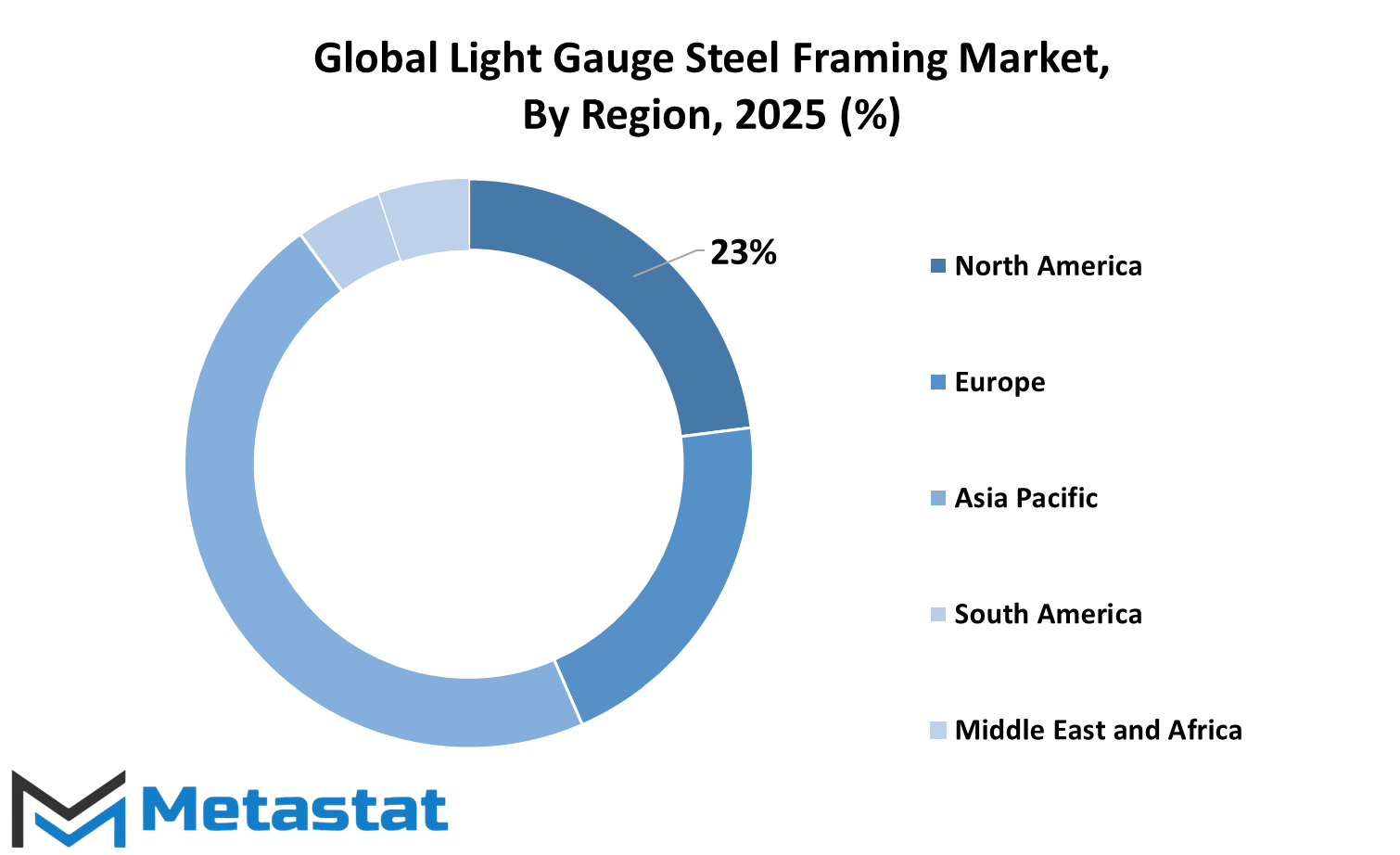
COMPETITIVE PLAYERS
Light Gauge Steel Framing is one of the significant markets and companies, including Nucor Corporation, ArcelorMittal S.A., Tata Steel Ltd., and Lindab Group, that dominate this sector, have shaped it to this present status through innovations and expansions. As the demand for sustainable construction solutions rises, so does the position of these companies at the forefront of the market by providing an efficient and durable steel framing system. The evolving new technologies and ever-growing demand for sustainable building materials make them develop further from the competition.
For instance, Knauf Group and Hadley Group have been working on making steel framing more versatile. They offer products that can be used in different types of buildings and under various environmental conditions. Their ability to adapt to the changing needs of the construction industry gives them an edge as they continuously improve the design, manufacturing, and delivery processes. In addition, ClarkDietrich Building Systems and Framecad Limited have been part of what would shape the future of the market by introducing the use of steel framing for residential, commercial, and industrial projects.
In the coming years, competition within the Light Gauge Steel Framing market around the world will continue to intensify as people continue to look for faster, cost-effective ways to construct. This demand will most likely fuel further innovation among market players, and the result will be lighter, stronger, and more sustainable steel framing products. Companies such as Scottsdale Construction Systems Ltd., Steel Framing Alliance, and Fletcher Building Limited are best placed to benefit from this trend by continuing to develop cutting-edge framing systems that can be quickly assembled on-site while reducing waste.
Meanwhile, Kingspan Group Plc and Metek UK Limited are playing a very important role in pushing the boundaries of energy-efficient construction. As regulations around building performance and sustainability become stricter, these companies will likely lead the charge in providing solutions that not only meet the standards but exceed them. Their commitment to green building practices will help define the future of the global Light Gauge Steel Framing market, which is bound to experience great growth over the next decade.
These key players are expected to stay ahead of the curve in a changing industry. They will propel progress through innovation, collaboration, and focus on delivering high-quality, sustainable building solutions. In fact, this is where the future of the market is very promising as it shapes the way forward for more efficient, durable, and environmentally friendly buildings to be constructed across the globe.
Light Gauge Steel Framing Market Key Segments:
By Type
- C-shaped
- L-shaped
- U-shaped
- T-shaped
By Construction Type
- Wall Systems
- Roof Systems
- Floor Systems
- Ceiling Systems
By Application
- Residential
- Commercial
- Industrial
By End-Use
- New Construction
- Renovation
Key Global Light Gauge Steel Framing Industry Players
- Nucor Corporation
- ArcelorMittal S.A.
- Tata Steel Ltd.
- Lindab Group
- Knauf Group
- Hadley Group
- ClarkDietrich Building Systems
- Framecad Limited
- Scottsdale Construction Systems Ltd.
- Steel Framing Alliance
- Fletcher Building Limited
- Kingspan Group Plc
- Metek UK Limited
WHAT REPORT PROVIDES
- Full in-depth analysis of the parent Industry
- Important changes in market and its dynamics
- Segmentation details of the market
- Former, on-going, and projected market analysis in terms of volume and value
- Assessment of niche industry developments
- Market share analysis
- Key strategies of major players
- Emerging segments and regional growth potential



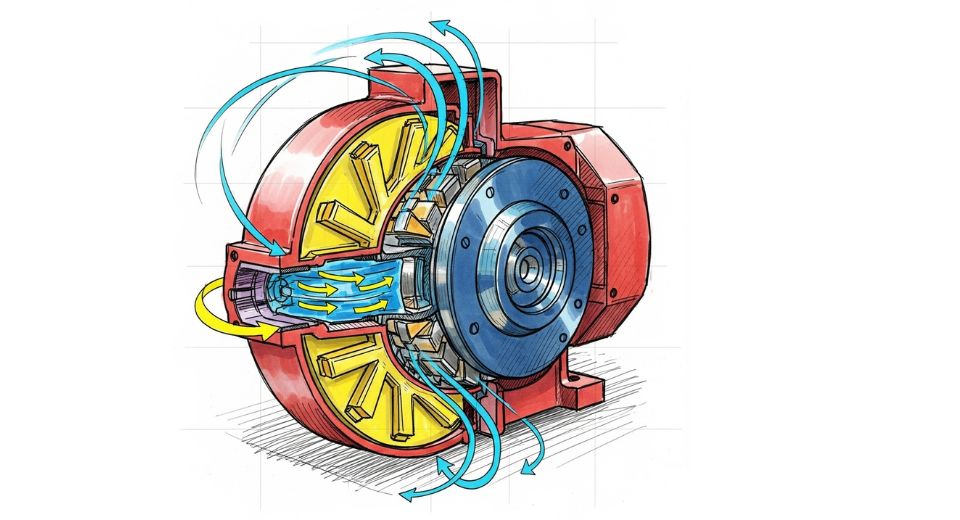
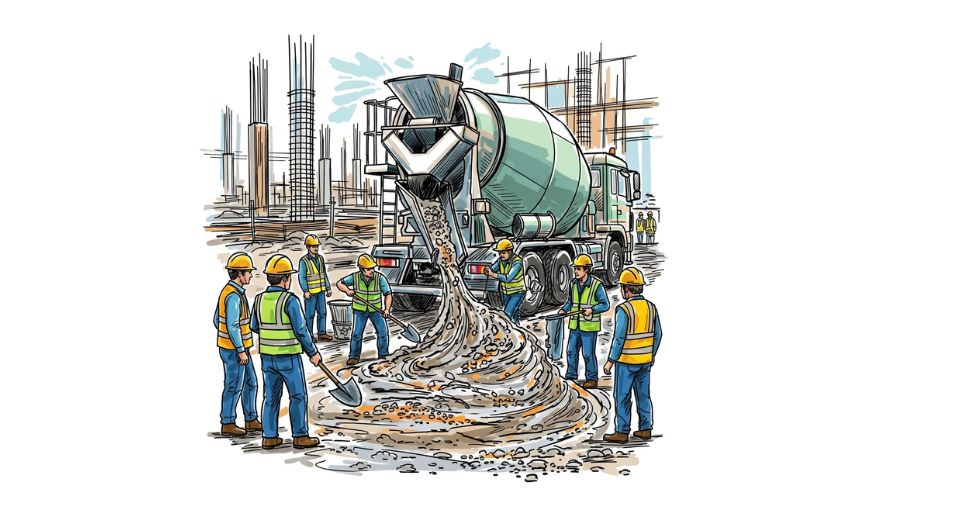
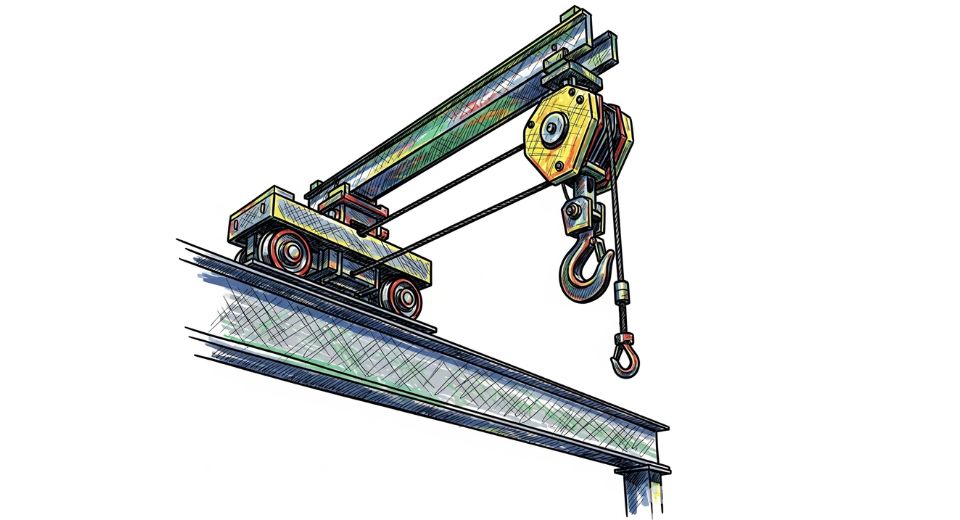


 US: +1 3023308252
US: +1 3023308252






